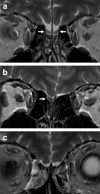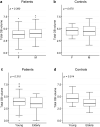MRI evidence of olfactory system alterations in patients with COVID-19 and neurological symptoms
- PMID: 36656356
- PMCID: PMC9850323
- DOI: 10.1007/s00415-023-11561-0
MRI evidence of olfactory system alterations in patients with COVID-19 and neurological symptoms
Abstract
Background and objective: Despite olfactory disorders being among the most common neurological complications of coronavirus disease 2019 (COVID-19), their pathogenesis has not been fully elucidated yet. Brain MR imaging is a consolidated method for evaluating olfactory system's morphological modification, but a few quantitative studies have been published so far. The aim of the study was to provide MRI evidence of olfactory system alterations in patients with COVID-19 and neurological symptoms, including olfactory dysfunction.
Methods: 196 COVID-19 patients (median age: 53 years, 56% females) and 39 controls (median age 55 years, 49% females) were included in this cross-sectional observational study; 78 of the patients reported olfactory loss as the only neurological symptom. MRI processing was performed by ad-hoc semi-automatic processing procedures. Olfactory bulb (OB) volume was measured on T2-weighted MRI based on manual tracing and normalized to the brain volume. Olfactory tract (OT) median signal intensity was quantified on fluid attenuated inversion recovery (FLAIR) sequences, after preliminary intensity normalization.
Results: COVID-19 patients showed significantly lower left, right and total OB volumes than controls (p < 0.05). Age-related OB atrophy was found in the control but not in the patient population. No significant difference was found between patients with olfactory disorders and other neurological symptoms. Several outliers with abnormally high OT FLAIR signal intensity were found in the patient group.
Conclusions: Brain MRI findings demonstrated OB damage in COVID-19 patients with neurological complications. Future longitudinal studies are needed to clarify the transient or permanent nature of OB atrophy in COVID-19 pathology.
Keywords: COVID-19; MRI; Olfactory bulbs; Olfactory dysfunction; Olfactory system.
© 2023. The Author(s), under exclusive licence to Springer-Verlag GmbH Germany.
Conflict of interest statement
There are no competing interests to declare.
Figures






Similar articles
-
Transient modifications of the olfactory bulb on MR follow-up of COVID-19 patients with related olfactory dysfunction.J Neuroradiol. 2022 Jun;49(4):329-332. doi: 10.1016/j.neurad.2022.03.003. Epub 2022 Mar 17. J Neuroradiol. 2022. PMID: 35306004 Free PMC article.
-
Association of olfactory training with olfactory bulb morphology in adults with post-viral long-lasting olfactory dysfunction: A COVID-19 related prospective study.Auris Nasus Larynx. 2025 Feb;52(1):76-83. doi: 10.1016/j.anl.2025.01.006. Epub 2025 Jan 21. Auris Nasus Larynx. 2025. PMID: 39971413
-
Olfactory Bulb Signal Abnormality in Patients with COVID-19 Who Present with Neurologic Symptoms.AJNR Am J Neuroradiol. 2020 Oct;41(10):1882-1887. doi: 10.3174/ajnr.A6751. Epub 2020 Aug 27. AJNR Am J Neuroradiol. 2020. PMID: 32855190 Free PMC article.
-
Olfactory system measurements in COVID-19: a systematic review and meta-analysis.Neuroradiology. 2023 Jan;65(1):25-39. doi: 10.1007/s00234-022-03014-8. Epub 2022 Jul 18. Neuroradiology. 2023. PMID: 35843987 Free PMC article.
-
Post-viral effects of COVID-19 in the olfactory system and their implications.Lancet Neurol. 2021 Sep;20(9):753-761. doi: 10.1016/S1474-4422(21)00182-4. Epub 2021 Jul 30. Lancet Neurol. 2021. PMID: 34339626 Free PMC article. Review.
Cited by
-
Mapping the Olfactory Brain: A Systematic Review of Structural and Functional Magnetic Resonance Imaging Changes Following COVID-19 Smell Loss.Brain Sci. 2025 Jun 27;15(7):690. doi: 10.3390/brainsci15070690. Brain Sci. 2025. PMID: 40722282 Free PMC article. Review.
-
A Comprehensive Review of COVID-19-Related Olfactory Deficiency: Unraveling Associations with Neurocognitive Disorders and Magnetic Resonance Imaging Findings.Diagnostics (Basel). 2024 Feb 7;14(4):359. doi: 10.3390/diagnostics14040359. Diagnostics (Basel). 2024. PMID: 38396398 Free PMC article. Review.
-
Long COVID-19-related and non-COVID-19 postviral olfactory dysfunction a comparative MRI study focusing on the olfactory cleft and bulbs.Front Neurol. 2025 Jan 15;15:1535699. doi: 10.3389/fneur.2024.1535699. eCollection 2024. Front Neurol. 2025. PMID: 39882367 Free PMC article.
-
Functional Connectivity Alterations Associated with COVID-19-Related Sleep Problems: A Longitudinal Resting-State fMRI Study.Nat Sci Sleep. 2025 Jan 15;17:97-113. doi: 10.2147/NSS.S488911. eCollection 2025. Nat Sci Sleep. 2025. PMID: 39839964 Free PMC article.
-
The Growing Understanding of the Pituitary Implication in the Pathogenesis of Long COVID-19 Syndrome: A Narrative Review.Adv Respir Med. 2024 Feb 14;92(1):96-109. doi: 10.3390/arm92010013. Adv Respir Med. 2024. PMID: 38392036 Free PMC article. Review.
References
-
- WHO Coronavirus (COVID-19) Dashboard. https://covid19.who.int/. Accessed 28 Feb 2022
Publication types
MeSH terms
LinkOut - more resources
Full Text Sources
Medical
Miscellaneous

